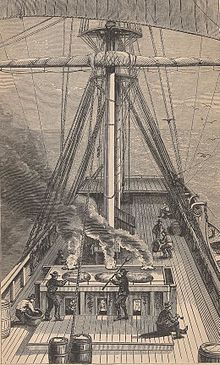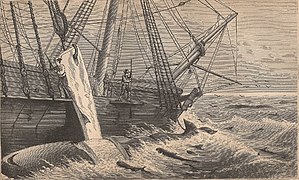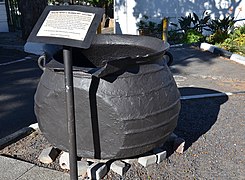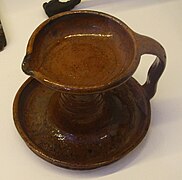Whale oil

Whale oilisoilobtained from theblubberofwhales.[1]Oil from the bowhead whale was sometimes known astrain-oil,which comes from the Dutch wordtraan( "tear drop" ).
Sperm oil,a special kind of oil obtained from the head cavities ofsperm whales,differs chemically from ordinary whale oil: it is composed mostly of liquidwax.Its properties and applications differ from those of regular whale oil, and it was sold for a higher price.
Source and use[edit]
Emerging industrial societies used whale oil inoil lampsand tomake soap.In the 20th century it was made intomargarine.With the commercial development of thepetroleum industryandvegetable oils,the use of whale oils declined considerably from its peak in the 19th century into the 20th century. This is said to have saved whales fromextinction.[2]In the 21st century, with most countries having banned whaling, the sale and use of whale oil has practically ceased.
Whale oil was obtained by boiling strips ofblubberharvested from whales.[3]The removal is known asflensingand the boiling process was calledtrying out.The boiling was carried out on land in the case of whales caught close to shore or beached. On longer deep-sea whaling expeditions, the trying-out was done aboard the ship in afurnaceknown as atryworkand thecarcasswas then discarded into the water.
Baleen whaleswere a major source of whale oil. Their oil is exclusively composed oftriglycerides,whereas that oftoothed whalescontainswax esters.[4]Thebowhead whaleandright whalewere considered the ideal whaling targets. They are slow and docile, and they float when killed. They yield plenty of high-quality oil andbaleen,[5]and as a result, they were hunted nearly to extinction.
Chemistry[edit]

Whale oil has lowviscosity(lower thanolive oil),[6]is clear, and varies in color from a bright honey yellow to a dark brown, according to the condition of the blubber from which it has been extracted and the refinement through which it went.[7]It has a strongfishy odor.Whenhydrogenated,it turns solid and white and its taste and odor change.[8][9]Its composition varies with the species from which it was sourced and the method by which it was harvested and processed. It is composed mainly oftriglycerides[10](molecules offatty acidsattached to aglycerolmolecule). Oil sourced from toothed whales, especially theoil of sperm whales,contains a substantial amount of waxesters.[4]Most of the fatty acids are unsaturated. The most common fatty acids areoleic acidand its isomers (18:1 carbon chains).[11]Whale oil is exceptionally stable.[12]
| Specific gravity | 0.920 to 0.931 at 15.6 °C (60.1 °F)[13] |
| Flash point | 230 °C (446 °F)[14] |
| Saponification value | 185–202[10] |
| Unsaponifiable matter | 0–2%[10] |
| Refractive index | 1.4760 at 15 °C (59 °F)[15] |
| Iodine value(Wijs) | 110–135[10] |
| Viscosity | 35–39.6 cSt at 37.8 °C (100.0 °F)[6] |
Applications[edit]


The main use of whale oil was forilluminationand machinelubrication.[16]Cheaper alternatives to whale oil existed, but were inferior in performance and cleanliness of burn. As a result, whale oil dominated the world for both uses. This in turn further fueled theIndustrial Revolution,inthe United States,inBritain,andcontinental Europe.As demand for whale oil increased at the end of the 18th century, thewhalingindustry expanded until its peak around the 1820s, when piped coal-gas networks began to provide an alternative lighting fuel in urban areas. Due to dwindling whale populations causing higher voyage costs, as well astaxation,the market changed rapidly in the 1860s after the discovery ofmineral oilsand expansion ofchemical refineriesto producekeroseneandlubricants.By 1870, kerosene became the dominant illumination fuel and the whaling industry was in decline.[17]
The use of whale oil had a steady decline starting in the late 19th century due to the development of superior alternatives, and later, the passing ofenvironmental laws.[1]In 1986, theInternational Whaling Commissiondeclared amoratoriumoncommercial whaling,which has all but eliminated the use of whale oil today.Aboriginal whaling,part of thesubsistence economy,is still permitted. Groups such as theInuitof North America are granted special whaling rights, integral totheir culture,and they still use whale oil as a food and as lamp oil in the ceremonialqulliq.[18][19]
Whale oil was used as a cheap illuminant, though it gave off a strong odor when burnt and was not very popular.[20]It was replaced in the late 19th century by cheaper, moreefficient,and longer-lastingkerosene.[21]Burning fluid andcamphinewere the dominant replacements for whale oil until the arrival of kerosene.[22]
In the United States, whale oil was used in cars as a constituent ofautomatic transmission fluiduntil it was banned by theEndangered Species Act of 1973.[23]It was also a major component ofhydraulic fluidintractors(like the ubiquitous JDM Type 303 Special Hydraulic Fluid) until its withdrawal in 1974.[24]
In the United Kingdom, whale oil was used in toolmaking machinery as a high-quality lubricant.[25]
After the invention ofhydrogenationin the early 20th century, whale oil was used to make margarine,[8]a practice that has since been discontinued. Whale oil in margarine has been replaced byvegetable oil.[26]
Whale oil was used to make soap. Until the invention of hydrogenation, it was used only in industrial-grade cleansers, because its foul smell and tendency to discolor made it unsuitable for cosmetic soap.[9]
Whale oil was widely used in theFirst World Waras apreventive measureagainsttrench foot.An infantry battalion of theBritish Army during World War Ion theWestern Frontcould be expected to use 10 imp gal (45 L; 12 US gal) of whale oil a day. The oil was rubbed directly onto bare feet in order to protect them from the effects of immersion.[27]
Gallery[edit]
-
Whalers stripping blubber from a whale
-
Try potorBlubber Potseen inSimon's Townin South Africa
-
Men boiling the blubber of a beached blackfish atTokerau Beach.(New Zealand, 1911)
-
Whale oil lamp in brown-glazed earthenware with candle bowl for the wick and base drip pan. Lyse parish,Bohuslän– now in theNordic Museum,Stockholm,Sweden
Literature[edit]
The pursuit and use of whale oil, along with many otheraspects of whaling,are discussed inHerman Melville's1851 novel,Moby-Dick.The novel's narrator is sometimes misquoted as saying that whale oil is "as rare as the milk of queens".[28][29]The quote is:
In merchantmen, oil for the sailor is more scarce than the milk of queens.
According to the rest of the paragraph, sailors onboard themerchantmanhad to sleep, dress, and maneuver below decks in the dark as opposed to the whalers who used the oil for light.[30]
John R. Jewitt,an Englishman who wrote a memoir about his years as a captive of theNuu-chah-nulth(Nootka), anIndigenous Pacific Northwest peopleon theBritish Columbia Coast,from 1802 to 1805, claimed whale oil was a condiment with every dish, even strawberries.[citation needed]
In Robert Browning'sPied Piper(§ VII), the Piper's piping leads the rats to imagine the sound of "breaking the hoops of train-oil flasks".
Friedrich RatzelinThe History of Mankind(1896), when discussing food materials inOceania,quoted CaptainJames Cook's comment in relation to theMāori people:"No Greenlander was ever so sharp set upon train-oil as our friends here, they greedily swallowed the stinking droppings when we were boiling down the fat of dog-fish."[31]
See also[edit]
References[edit]
- ^ab
Ed Butts (October 4, 2019)."The cautionary tale of whale oil".The Globe and Mail.Archivedfrom the original on October 6, 2019.RetrievedOctober 7,2019.
Then in 1846, a Nova Scotian physician and geologist named Abraham Gesner invented kerosene. This pioneering form of fossil fuel, which some called coal oil, burned cleaner and brighter than whale oil, and didn't have a pungent odour.
- ^Column: Markets and consumers, not president, control oil's future
- ^Barfield, Rodney (1995).Seasoned by Salt.Chapel Hill: University of North Carolina Press. p. 64.ISBN0-8078-2231-0.
- ^abRice, Dale W. (2009). "Spermaceti".Encyclopedia of Marine Mammals(Second ed.). pp. 1098–1099.doi:10.1016/B978-0-12-373553-9.00250-9.ISBN9780123735539.
- ^Clapham, Phil (2004).Right Whales: Natural History & Conservation.Stillwater, MN: Voyageur Press. p.8.ISBN0-89658-657-X.
- ^ab"Liquids – Kinematic Viscosities".engineeringtoolbox.
- ^One or more of the preceding sentences incorporates text from a publication now in thepublic domain:Chisholm, Hugh,ed. (1911). "Whale-oil".Encyclopædia Britannica.Vol. 28 (11th ed.). Cambridge University Press. pp. 573–574.
- ^abTønnessen, Johan Nicolay; Johnsen, Arne Odd (January 1, 1982).The History of Modern Whaling.University of California Press.ISBN978-0-520-03973-5.
- ^abWebb, Robert Lloyd (November 1, 2011)."5. Warring On Whales".On the Northwest: Commercial Whaling in the Pacific Northwest, 1790-1967.University of British Columbia Press.p. 144.ISBN9780774843157.
- ^abcdChakrabarty, Moninder Mohan (November 9, 2003).Chemistry And Technology Of Oils And Fats.Allied Publishers. p. 183.ISBN9788177644951.
- ^Bottino, Nestor R. (1971)."The composition of marine-oil triglycerides as determined by silver ion-thin-layer chromatography".Journal of Lipid Research.12(1): 24–30.doi:10.1016/S0022-2275(20)39542-0.PMID5542701.
- ^"Reinventing the Whale"(PDF).WDCS: Whale and Dolphin Conservation Society. May 2010. Archived fromthe original(PDF)on June 1, 2013.RetrievedOctober 29,2012.
- ^Dieterichs, Emil F. (1916)."Whale and Train Oils".A practical treatise on friction, lubrication, fats and oils, including the manufacture of lubricating oils, leather oils, paint oils, solid lubricants and greases, modes of testing oils, and the application of lubricants.Henry Carey Baird. p. 23.
- ^Sims, Frank (1999).Engineering Formulas Interactive: Conversions, Definitions, and Tables.Industrial Press.p. 132.ISBN9780831130879.
- ^Kanthack, R. (1918–1921)."Refractive Indices of Oils, Fats and Waxes".In Goldsmith, John Naish (ed.).Tables of refractive indices.Vol. II. A. Hilger, limited. p. 259.
- ^"Whale Oil".petroleumhistory.org.RetrievedMarch 27,2021.
- ^"Understanding the Whale Oil Myth and the Rise of Petroleum".Petroleum Service Company.RetrievedMarch 27,2021.
- ^"The Bowhead Whale – An Inuit Tradition".RetrievedOctober 30,2021.
- ^"Inuit and Marine Mammals".RetrievedOctober 30,2021.
- ^Heflin, Wilson (April 12, 2004).Herman Melville's Whaling Years.Vanderbilt University Press.p. 232.ISBN9780826591449.
- ^"Thefreemanonline.org".thefreemanonline.org.January 5, 2020.
- ^"The" Whale Oil Myth "".PBS NewsHour.August 20, 2008.
- ^Information, Reed Business (May 1, 1975)."New Scientist".Reed Business Information – via Google Books.
{{cite web}}:|first=has generic name (help) - ^"The Yellow Bucket",Thomas Glenn,Lubes N' Greases,LND Publishing Co., Inc., February 2012, Vol. 18, No. 2, p.12.
- ^Norman Atkinson, Sir Joseph Whitworth (Sutton Publishing 1996), p161.
- ^Gorman, Martyn (2002)."Whale oil and margarine".Scran.Historic Environment Scotland.Archivedfrom the original on February 20, 2020.
- ^"Trench Foot".spartacus-educational.
- ^"The harsh history behind the internet's favorite sea shanty".Mashable.January 20, 2021.Archivedfrom the original on January 20, 2021.RetrievedOctober 30,2021.
- ^"The spoils of oils".September 15, 2017.Archivedfrom the original on September 27, 2017.RetrievedOctober 30,2021.
- ^abMelville, Herman(1851). "Chapter 97. The Lamp.".Moby-Dick.
- ^Friedrich, Ratzel."The Races of Oceania – Labour, Dwellings and Food in Oceania – Similarities and coincidences in labour and implements of labour, Food".inquirewithin.biz.Archived fromthe originalon April 30, 2012.RetrievedMay 10,2018.
Further reading[edit]
- Whale oil and its uses,an overview with illustrations
- Knapp, Friedrich Ludwig; Dibdin, William Joseph (1895),"Whale oil – Train-oil",Chemical technology: or, Chemistry in its applications to arts and manufactures,vol. II, Lighting, London: J & A Churchill, pp. 43–44,OCLC3592958
- Stevenson, C H;United States Fish Commission(1903),"Conversion of blubber into whale oil, Refining sperm oil and whale oil",Aquatic products in arts and industries: Fish oils, fats, and waxes, fertilizers from aquatic products. U.S. Fish Commission Report, 1902,Washington, DC: GPO, pp. 193–204,OCLC21059426,Includes descriptions, photographs and statistics.
- Tower, Walter Sheldon (1907),A history of the American whale fishery,Series in political economy and public law, no. 20, Philadelphia: Published for the University, pp. 94–95,ISBN1-116-72422-7,OCLC145429333
- How Capitalism Saved the Whales,by James S. Robbins
- Coleman, James L Jr. (1995), "The American Whale Oil Industry: A Look Back at the Future of the American Petroleum Industry",Natural Resources Research,4(3)
External links[edit]
 Media related toWhale oilat Wikimedia Commons
Media related toWhale oilat Wikimedia Commons






